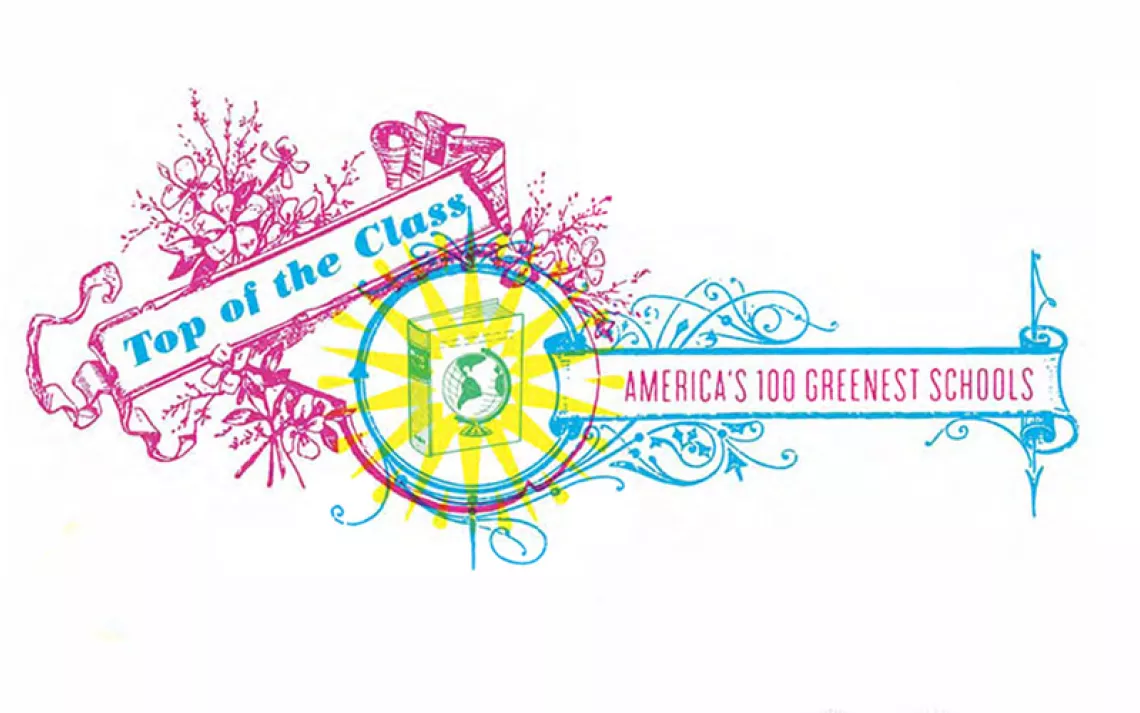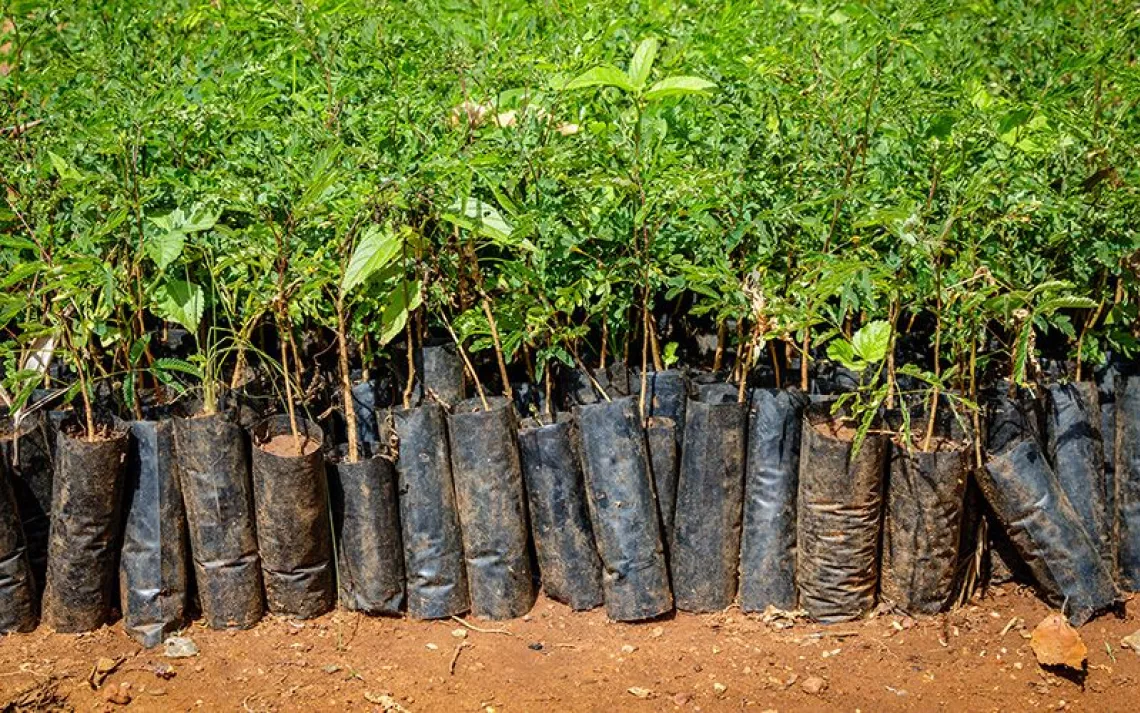The Wizard of Oberlin
Professor David Orr turns everything emerald

Professor David Orr and his students, Oberlin College, June 2012. "Hope," he often tells them, "is a verb with its sleeves rolled up." | Photo by Raymundo Garza
The bearded owner of an Oberlin, Ohio, antique store looks up from his copy of Captain Salt in Oz with a patient smile. His shop is packed with milk cans, hand tools, and other artifacts from the surrounding farm and rust belt. When I ask about upcoming changes in the town he calls home, he eyes me warily.
I've come to what may be the epicenter of America's economic, educational, and environmental salvation to meet a man some see as a wizard. His name is David Orr, and he has a big plan for turning little Oberlin College (2,800 students) and the little town of Oberlin (population 8,300) into a model of how our species can live more harmoniously with the rest of nature. It's called the Oberlin Project, and the goal is transforming everything from how people on campus and in town produce and use energy to how they build, eat, teach, and learn.
The shop owner says that lots of schemes have spilled from the college in the 32 years he's lived in Oberlin, and although he doesn't know much about this project, which has been taking shape for two years, he's as skeptical of it as he has been of others. "People say it's going to make them do things and cost them money," he says.
As I leave, I check out a display of Tonka-style toy metal vehicles. Although life-size versions still prowl America's highways, in context the rust-specked garbage truck and the yellow Shell Oil tanker seem like remnants of a fading era. They stir the realization that in investigating what Oberlin is trying to do, I'm exploring the terra incognita between past and future, reality and imagination—a realm called "change," which has probably frightened folks since our species took its first wobbly steps.
Two bits of eco-news caught my attention as I prepared for my springtime visit to Ohio. On the New York Times op-ed page, NASA scientist James Hansen sounded his latest cri de coeur about climate disruption's dystopian impact on our soon-to-be-overcooked little planet. "If this sounds apocalyptic," he wrote, "it is."
Then came the death of author Ernest Callenbach, whose 1975 novel Ecotopia reflected the utopian hope of a generation and helped accelerate the modern age of environmental activism. Callenbach's big ideas were woven into the Emersonian warp and Orwellian woof of many a college rap session back then. I'd never read it, though, so I loaded it onto a Kindle and clicked through it during the flight from San Francisco to Cleveland. The protagonist, a Manhattan-based foreign correspondent, is the first reporter to venture to the fledgling nation of Ecotopia (Northern California, Oregon, and Washington), 20 years after it has seceded from the United States to engender a sustainable, clean-energy environmental Eden.
I'm feeling a bit like a foreign correspondent myself as Orr barrels into the Oberlin Inn to greet me—though I'm hardly the first to come snooping around the college and town that are becoming, as a Chronicle of Higher Education reporter put it, "a laboratory for a new way of life."
I first met Orr, the author of such influential books as Design on the Edge and The Nature of Design, several months earlier at the VerdeXchange Green Markets conference in Los Angeles, where he'd given one of the 500 or so talks he's presented nationwide over the past eight years.
On the day of my visit to Oberlin, Orr, who calls himself a type A personality—"possibly triple A"—is still moving fast. The married father of two grown sons has just returned from giving the commencement address at Colorado's Naropa University and is flying to Washington, D.C., in the afternoon for more speeches and fundraising. But first he's eager to show me where the $55 million that has already been raised has gone and where the additional $75 million the school is trying to collect will go.
Orr leads me out of the college-owned hotel, noting over his shoulder that it will, if all goes right, soon become the LEED "beyond Platinum" centerpiece of the project's 13-acre green arts district. An energy-efficient conference center, Orr says with a confident wave of his hand, will routinely draw the sorts of folks who have the influence to help the project's big ideas evolve and spread. A 20,000-acre greenbelt surrounding the town will provide organic food for a new four-star hotel and restaurants.
After crossing the street, Orr sticks his head inside the Apollo Theater, which first opened in 1913 and now bustles with a construction crew putting final touches on an environmentally sound upgrade. Oberlin faculty will use the theater to teach cinematography to students and interested area residents. Other elements already completed or in the works include a black box theater; solar-powered, LEED-rated construction projects with community colleges and local schools; and affordable housing. City administrators, educators, business leaders, and philanthropists have been tapped for their expertise, and as one of 18 projects in the Clinton Climate Initiative, the college and town's combined efforts are becoming a template for how other entities and places (military bases, for example) can stop contributing to climate disruption and become carbon neutral.
"This little town, with its good people, could be—with just a bit of social and political acupuncture—the first example of integrated sustainability," Orr says.
Orr, 68, grew up in Pennsylvania farm country, the son of a father who was a minister and a professor. It was a time when Thoreau's all-American respect for humans' protective place in nature had been amplified into an alarm by such authors as Aldo Leopold and Rachel Carson, and when social concerns were being refracted in a thousand directions by the thinkers of the 1960s. "The environmental movement," Orr says, "helped me connect the dots between urban unrest, civil rights, Vietnam, and a society that had come off the rails."
He began his academic career teaching political science at Agnes Scott College in Georgia and then at the University of North Carolina at Chapel Hill. Fired up by the ideas of Theodore Roszak (The Making of a Counter Culture) and Ian McHarg (Design With Nature), among others, he soon came to believe that academia was so "marinated in complacency" that it was squandering the enthusiasm of students eager to apply their newfound knowledge to the mess they'd inherited. "The academy wanted to separate the feeling part of people from the analytical part," he says. Orr encouraged students to explore the connections between land, food, health, and shelter: "I wanted to prepare young people for life on Earth."
With his brother, Wilson, Orr bought a 1,500-acre farm in Arkansas's Ozarks and created the Meadowcreek Project, an experimental school that hosted what Orr calls the "first conference on sustainability."
By the end of the 1980s, Orr was ready to move on. "I was a better pioneer than settler," he says. He landed at Oberlin in 1990 as a professor of politics and environmental studies.
"I can't imagine any other institution that would let me do what I've done," Orr says as he leads me across a park where the identities of the town and the eponymous 180-year-old campus meld. In the administration building, Orr introduces a staffer as "pure trouble" and me as "an emissary from Dick Cheney's office." When the president's chief of staff volunteers that her biggest job is "keeping David under control," a wisp of a smile crosses Orr's face.
For his part, Oberlin president Marvin Krislov treats Orr like a prize bull that he fully respects—"David is visionary, inspirational"—while keeping one hand on a high-voltage cattle prod. Both the town and the college, Krislov notes, were founded by abolitionists, and both have always embraced the sort of social change that often discomfits others. "Creating a better world is deep in Oberlin's DNA."
As we continue deeper into the campus, Orr ruminates on the patience required to navigate the inefficiencies of democracy while listening to the tick-tick-tick that says that ending our dependence on fossil fuels and squandering of resources should have happened yesterday.
We arrive at what is probably the most tangible artifact of Orr's approach to making things happen. Long before the Oberlin Project, he and his colleagues began cooking up the idea of a new environmental studies building. School administrators and directors, he says, told him they'd support the building if he raised the money—but added that he could not tap existing donors. "That left me with the Colombian drug cartel," he deadpans.
From conception, the building, completed in 2001 on a 1-acre site, was meant to be an example of what colleges and universities could aspire to if they were serious about addressing the spectrum of environmental problems that traditional buildings either cause or fail to address.
Orr brought in experts to draft plans and then opened the design process to students. The criteria: "Create no ugliness, human or ecological." The result: the Adam Joseph Lewis Environmental Center, a $7.2 million, 13,600-square-foot glass-and-steel edifice that Architect magazine called "the most important green building constructed since 1980."
That importance, in part, owes to the role the building played in jump-starting college sustainability efforts nationwide. Orr points to the surrounding garden, orchard, and artificial wetlands populated with indigenous plants and animals. Inside, Orr strokes the auditorium's compressed-wheat-straw acoustic tiles. He taps his toe on the brown slate tiles that cover a radiant, geothermal heating system. He presses his finger on a window looking into the Living Machine greenhouse, essentially an indoor wetland that processes sewage into water to flush toilets and irrigate.
As our tour continues, Orr calls out to professors and to students caught up in the stress of finals week. Ben Jones says that he was lured to attend Oberlin in 1992, in part by a poster of a globe and the words "Think one person can change the world? So do we." Jones returned a few years ago to take a job in communications and to support the project, in part because he had taken Orr's Environment and Society class and was impressed by the professor's knack for blending realism and humor to instill a "let's get it done" attitude.
"David will take you down a very dark road about significant challenges, and then just when you think you can't take any more, he'll make you laugh," Jones says. "If you talk to him long, you'll hear him say, 'Hope is a verb with its sleeves rolled up.'"
Orr's view of hope during an age when the parts per billion of carbon in the atmosphere is approaching catastrophic levels is not unlike his view of patience: Both are practical values. "It's a tough time to be a teacher," the professor says. "Kids' hormones tell them to be optimistic. The numbers tell them differently." So he has taken a lesson from E.F. Schumacher, author of Small Is Beautiful and A Guide for the Perplexed. "Schumacher said that if you ask, 'Can humankind survive?' and answer no, people become despondent. If you answer yes, they become complacent. So instead, [Schumacher] says, 'Get down to work.'"
With the school's bell tower chiming in the distance, we step beneath a big carport covered with solar panels. A much bigger, 3-megawatt solar array will come online by the end of summer. It will help the college meet its goal of weaning itself from coal-fired energy in three to five years. Using geothermal, gas cogeneration, and efficiency measures, the school and the town are aiming to become carbon neutral by 2025.
Ecotopia, as it happens, struck me as didactic and sappy—awful, actually. Yet there's no denying that 40 years after the book's publication, the future it predicted is beginning to blossom, at least fitfully, in little Oberlin.
As he wheels his red Prius onto a side street, Orr says that he met Callenbach a few times and that he "hadn't thought of the connection." Maybe that's because the Oberlin Project, unlike Callenbach's naive fantasy, is "hugely pragmatic," he says. A moment later, he points out an abandoned supermarket and says that the project team is twisting the arm of a local organic-grocery owner, trying to persuade him to take it over. Then he shows me an elementary school that will be rebuilt along the lines of the environmental studies building and talks about plans to expand the definition of education in Oberlin to include classes in which local builders, welders, farmers, and craftspeople will share their skills.
When I raise the antique-shop owner's concern that the plan will cost locals money, Orr responds with a fusillade of data about funding mechanisms, including investments, tax credits, and bonds. He says that switching to clean energy and job-generating policies will actually save the townsfolk money almost immediately—as if that matters, he might have added, given the massive economic hardship that climate disruption is about to foist on people everywhere.
Before dumping me back at the inn, Orr points out a cylindrical edifice that once housed the town's coal gas but is now on the brink of becoming a museum to celebrate Oberlin's role as an Underground Railroad crossroads. He recommends a book about a pivotal moment in local history. It tells the story of the Oberlin abolitionists who got wind that bounty hunters had captured several runaway slaves, surrounded the jailhouse, and refused to leave until the captives were released. The book, he says, is called The Town That Started the Civil War.
Orr has met enough journalists to know that we are skeptical, averse to being spun. So he stops short of connecting the dots between this historic event and his emerald dream. Still, I'm pretty sure he knows he has planted a narrative seed, figuring I won't be able to resist ending this story with a pointed reflection about how the course of human events just might possibly be changed by a few brave souls embracing a bold vision.
Cunning man, Orr.
 The Magazine of The Sierra Club
The Magazine of The Sierra Club



